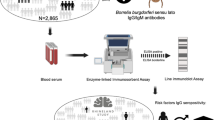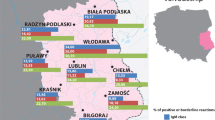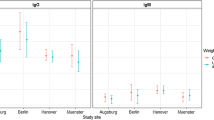Summary
BACKGROUND: This study concerns the prevalence of antibodies against B. burgdorferi sensu lato as an indicator of previous borrelial infection among hunters, a group of occupationally exposed persons. In order to define associated risk factors and preparing data for future comparisons, a study was performed in the eight districts of Burgenland, the most eastern state of Austria. METHODS: Blood samples of 1214 men (median age 51 years, range 18 to 89 years) and 39 women (median age 44 years, range 21 to 69 years) were collected during autumn 2002 and winter 2003. Demographic data regarding age, sex, profession, residence, duration of employment (hunters), hunting-ground, animals in the environment, and history of tick bite were obtained by a questionnaire. A two-step testing strategy was used in which sera were screened for antibodies against B. burgdorferi sensu lato by a commercially available recombinant enzyme-linked immunosorbent assay (Biotest Anti-Borrelia IgG ELISA; Biotest AG, Dreieich, Germany). Reactive sera were then subjected to immuno blot testing (recomBlot Borrelia; Mikrogen, Munich, Germany) for confirmation of specificity. RESULTS: A total of 673 (54%) sera tested positive for IgG antibodies to Borrelia burgdorferi sensu lato: 663 (55%) men and 10 (26%) women. Seropositivity was clearly related to age and duration of hunting activity; it was 33% among persons younger than 29 years and 83% in those older than 70 years. Further, there was also a difference in the distribution of seroprevalence within the districts; the highest was found in hunters from the most southern district of Burgenland, Jennersdorf, (69%) and the lowest was noticed in the most northern district, Neusiedl (39%). CONCLUSIONS: We found an overall seroprevalence of 54% in asymptomatic hunters of Burgenland. Infectious risk exists in the entire state but the prevalence rate differs in the various districts indicating a variable risk which peaks in the south. The nearly linear increase of seroprevalence with age and duration of hunting activity reflects repeated tick exposure.
Similar content being viewed by others
References
O'Connell S, Granström M, Gray JS, Stanek G (1998) Epidemiology of European Lyme Borreliosis. Zentralbl Bakteriol 287: 229–240
Christova I, Komitova R (2004) Clinical and epidemiological features of Lyme borreliosis in Bulgaria. Wien Klin Wochenschr 116: 42–46
Stanek G, Strle F (2003) Lyme borreliosis. Lancet 362: 1639–1647
Nadelmann RB, Wormser GP (1998) Lyme borreliosis. Lancet 352: 557–565
Strle F (1999) Principles of the diagnosis and antibiotic treatment of Lyme borreliosis. Wien Klin Wochenschr 111: 911–915
Anonymous (1995) Recommendations for test performance and interpretation from the second national conference on serological diagnosis of Lyme disease. Morb Mortal Wkly Rep 44: 590–591
Wilske B (2002) Microbiological diagnosis in Lyme borreliosis. Int J Med Microbiol 291 [Suppl 33]: 114–119
Wilske B, Zöller L, Brade V, Eiffert H, Göbel UB, Stanek G (2000) MiQ 12 2000 Quality standards for the microbiological diagnosis of infectious diseases: Lyme borreliosis, 1st edn. Urban and Fischer, Munich
Stanek G, Breier F, Menzinger G, Schaar B, Hafner M, Partsch H (1999) Erythema migrans and serodiagnosis by enzyme immunoassay and immunoblot with three borrelia species. Wien Klin Wochenschr 111 (22–23): 951–956
Report of WHO workshop on Lyme Borreliosis diagnosis and surveillance (1996) Warsaw, Poland, 20–22 June, 1995, WHO/CDS/VPH/95. 141–1220
Berglund J, Eitrem R, Ornstein K, et al (1995) An epidemiologic study of Lyme disease in southern Sweden. N Engl J Med 333: 1319–1327
Strle F (1999) Lyme borreliosis in Slovenia. Zentralbl Bakteriol 289: 643–652
Campbell GL, Fritz CL, Fish D, Nowakowski J, Nadelman RB, Wormser GP (1998) Estimation of the incidence of Lyme disease. Am J Epidemiol 148: 1018–1026
Guy EC, Bateman DE, Martyn CN, Heckels JE, Lawton NF (1989) Lyme disease: prevalence and clinical importance of Borrelia burgdorferi specific IgG in forestry workers. Lancet 1(8636): 484–486
Hunfeld KP, Ernst M, Zachary P, Jaulhac B, Sonneborn HH, Brade V (2002) Development and laboratory evaluation of a new recombinant ELISA for the serodiagnosis of Lyme disease. Wien Klin Wochenschr 114 (13–14): 580–585
Author information
Authors and Affiliations
Corresponding author
Rights and permissions
About this article
Cite this article
Cetin, E., Sotoudeh, M., Auer, H. et al. Paradigm Burgenland: Risk of Borrelia burgdorferi sensu lato infection indicated by variable seroprevalence rates in hunters. Wien Klin Wochenschr 118, 677–681 (2006). https://doi.org/10.1007/s00508-006-0694-y
Issue Date:
DOI: https://doi.org/10.1007/s00508-006-0694-y




